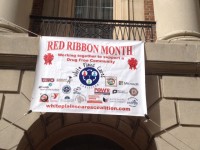White Plains Kicks Off Red Ribbon Month

The City of White Plains Youth Bureau, together with the Institute for Health & Wellness, the White Plains Cares Coalition, and Power Against Tobacco, kicked off Red Ribbon Month in White Plains Monday. Red Ribbon Month is celebrated nationally during the month of October as a means of promoting a drug free life for youth and adults.
Mayor Tom Roach, Congresswoman Nita Lowey and County Legislator Catherine Borgia were on hand to help raise awareness about drug abuse and to speak to youth about the importance of living a drug free life.
Mayor Roach explained that, “The City of White Plains participates in Red Ribbon Month each year because it is so important to keep reminding our youth in as many ways as possible that drugs are not the answer. The City offers many programs for its young people that are designed to provide positive, enriching experiences and through these experiences show them that there are real opportunities out there for them rather than the dead end of drug abuse. I urge our families to take advantage of these programs and those offered by our community partners. They will have lasting rewards and pay dividends in the future.”
Congresswoman Lowey commented on the unregulated chemicals in e-cigarettes, which she said are marketed to children with flavors like bubble gum, gummy bear, and Swedish fish. “Research overwhelmingly shows nicotine exposure can harm the adolescent brain and cause cognitive impairment, attention deficits, and other health issues. Six years ago, Congress passed the Family Smoking Prevention and Tobacco Control Act (TCA), which provided the FDA with authority to pass a regulation to regulate new tobacco products yet to be on the market, such as e-cigarettes, flavored hookahs, and flavored cigars. Today, I submitted a letter to the FDA urging finalization of this regulation – without delay – to protect youth from nicotine addiction and harmful chemicals, and to provide reliable information to adults about the risks associated with these products. I will continue working to ensure consumers know what is in the products they consume,” Lowey said.
County Legislator Borgia provided information about her pending legislation, Westchester County Tobacco 21, which aims to reduce access to cigarettes by young smokers by increasing the age for purchase of all tobacco products from 18 to 21 years of age.
“Similar to laws which were passed in New York City and Suffolk County, our Tobacco 21 legislation aims to raise the age for legal tobacco purchase to an age which will make it harder for Westchester high school students to obtain tobacco products. Unlike 19 year olds, 21 year olds are less frequently enrolled in high school classes, meaning it will be more difficult for an underage student to ask an of-age classmate to purchase tobacco for them. Compelling research exists that shows that delaying the start of use of tobacco exponentially diminishes the length and severity of lifetime use and adverse health impacts. Since Counties bear a significant portion of health care costs through Medicare and Medicaid, reducing the amount of smoking related health issues provides financial benefits to taxpayers and creates a healthier population,” Borgia said.
By wearing red ribbons and participating in community anti-drug events, participants pledge to live a drug-free life and at the same time pay tribute to DEA Special Agent Enriqué “Kiki” Camarena, who was killed in 1985 by drug traffickers. Several state parent organizations called on community groups to wear red ribbons during the last week of October as a symbol of their drug-free commitment in honor of Special Agent “Kiki” Camerana’s sacrifice. The first Red Ribbon Week celebrations were held in La Mirada and Norwalk, CA. In 1988, the National Family Partnership (NFP) coordinated the first National Red Ribbon Week with the President and Mrs. Reagan as chairpersons.
According to a press release distributed at the kick-off, Tobacco and its related products continue to remain the “gateway” to the use and abuse of other drugs among youth. In a recent national survey, over 90 percent of adult cocaine users between the ages of 18 and 34 had smoked cigarettes before they began using cocaine. The United States suffers from more than 400,000 tobacco- related deaths each year. According to a U.S. Department of Health and Human Services (HHS) report, tobacco use stands as the nation’s leading cause of preventable death, killing 480,000 people annually. Additionally, 85 percent of smokers begin before the age of 21 and 99 percent before the age of 26.
Prescription drug abuse among youth is another growing area of concern. According to the National Institute of Health, the nonmedical use and abuse of prescription drugs is a serious public health problem in this country. Although most people take prescription medications responsibly, an estimated 52 million people (20 percent of those aged 12 and older) have used prescription drugs for nonmedical reasons at least once in their lifetimes. Young people are strongly represented in this group. In fact, the National Institute on Drug Abuse’s (NIDA) Monitoring the Future (MTF) survey found that about one in twelve high school seniors reported past-year nonmedical use of the prescription pain reliever Vicodin in 2010, and one in twenty reported abusing OxyContin—making these medications among the most commonly abused drugs by adolescents.
